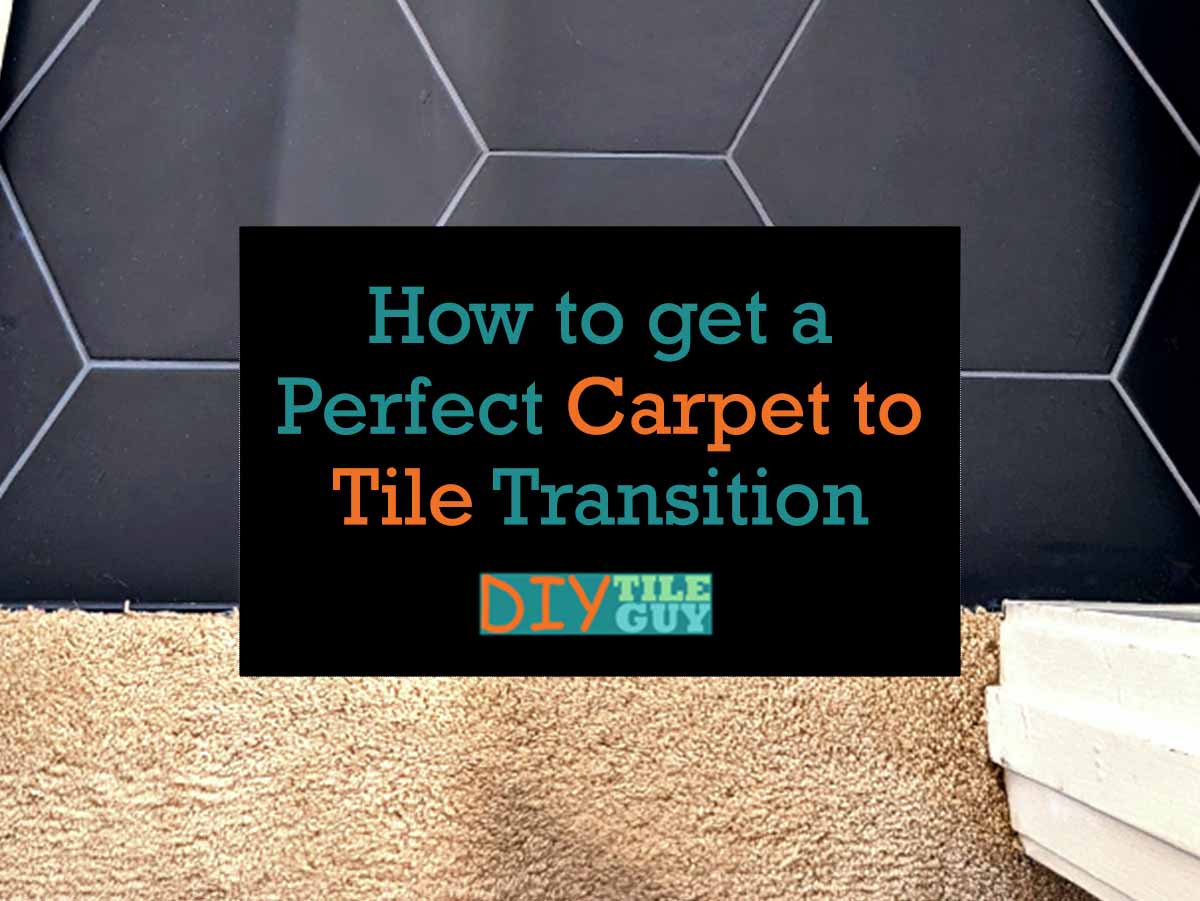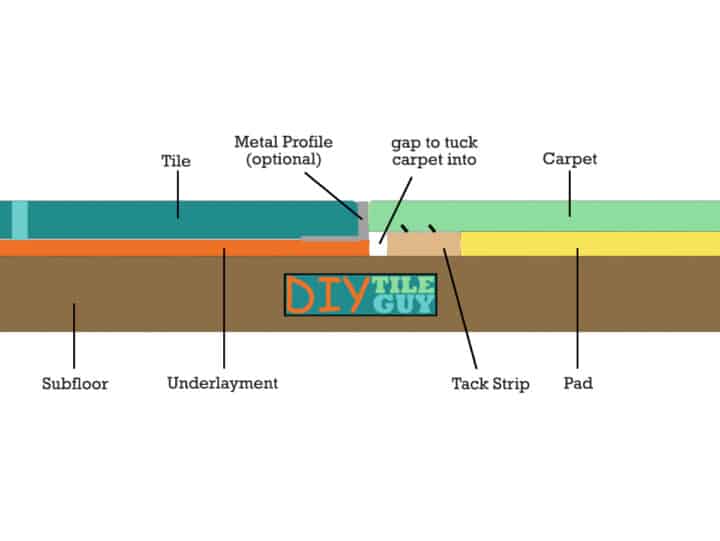In this post, I’m going to tell you exactly how you can have your carpet to tile transitions so they are flush, smooth, and even.
This is exactly what I do in my renovations all the time.
Estimated reading time: 5 minutes

How to Transition from Tile to Carpet
First of all, what does a perfect tile transition look like? In my book, it should involve these three things:
- The tile and carpet should be the same, or similar, heights
- The transition should be directly under a doorway (if applicable)
- The tile to carpet transition strip, if used, should be minimal and elegant
More on these three things below:
1. Tile and carpet should be the same or similar, heights
Tile and underlayment are designed to match up to other common flooring options, like carpet.
In fact, carpet is much easier to match up with than a tile-to-wood transition, for example.
Thickness of tile + underlayment
For the most part, a ceramic tile is 5/16 inch thick (+/-). Then, you add this to a tile underlayment, which is 1/8 inch thick for uncoupling membranes or 1/4 inch thick for cement backer board.
This works out to about 1/2-5/8 inch once thinset is accounted for.
Thickness of carpet over tack strip
Tack strip is 1/4 inch high and carpet also is at least 1/4 inch thick (it varies). So, we see that carpet + tackstrip is about 1/2 inch to 5/8 inch also.
So as long as carpet and tile are going over the same subfloor they will match up in thickness just fine.

2. The transition should be directly under a doorway
When installing tile in one room and carpet in another, the transition should take place directly under a door.
This way, when the door is closed, you won’t be able to see the flooring in the other room.
Doors are typically 1.5 inches thick, so you want the tile to extend 3/4 inch into the door jam. This way, it will transition under the exact middle of the doorway.
3. A carpet to tile transition strip should be elegant and minimal
Since carpet and tile match up evenly in height, a transition strip isn’t a requirement.
However, I still recommend using a transition strip where the two surfaces meet because a metal trim piece can help protect the edge of the tile from dangers such as an overly aggressive vacuum cleaner operator.
But keep in mind that a metal transition strip doesn’t mean a big and ugly piece of metal. Rather, it should be a nice, thin, and minimal tile trim piece that doesn’t ruin the look of your flooring.
When your carpet and tile are uneven
Sometimes, you will run into a situation where your tile and carpet do not match up evenly.
Often, the heights won’t line up if you’re working over a concrete subfloor. Many times, tile will be installed directly over the concrete, and the carpet will be higher.
Perhaps you’re working over a wood subfloor that has an additional layer of plywood subflooring for structural reasons. Adding plywood is also common underneath marble flooring.
Whatever the reason for the unevenness, the solution is one of two things:
- Make it so the transition is even
- Leave them uneven and use a transition strip for uneven floor heights.
How to make your uneven carpet to tile transition the same height
Typically, the reason for an uneven transition is that your tile and/or tile underlayment are thicker than normal.
Maybe you have floor heat installed in your floor. Perhaps you are using a thick, large-format tile. Maybe your subfloor is uneven.
No matter what the issue is, the solution is to bring the height of the carpet up to the height of the tile.
This is how you increase the height of carpet to match up with tile
To bring up the height of your carpet, you need to do one of two things:
- Install some carpet shims
- Float some patching compound
My friends at Hamilton Tile in Georgia show how to install carpet shims, or ramps, so that you can make your tile-to-carpet transition flush and even.
Another way of accomplishing this is to float a compound on the subfloor to ramp up to the tile. One of the products that I use in my floor-flattening video should work fine. I’ve also seen carpet layers use products similar to Fix-all for this purpose.
Uneven flooring
You may have a carpet with an uneven tile transition, and it’s best to leave it that way rather than try to even things out.
This might be because your carpet is glued to the subfloor with no pad underneath, or perhaps there is another reason.
If this is your situation, take a look at my post on uneven floor transitions.
Conclusion
We’ve covered how to achieve a perfectly even carpet-to-tile transition for most applications. Let me know what questions you have in the comments below.
Frequently Asked Questions about Carpet to Tile Transitions
If both carpet and tile are even then a transition strip is not required between the carpet and tile.
The metal strip between carpet and tile is called a tile edge profile. However, it’s often referred to as “Schluter trim” because Schluter Systems is the company that is most associated with tile edge profiles.